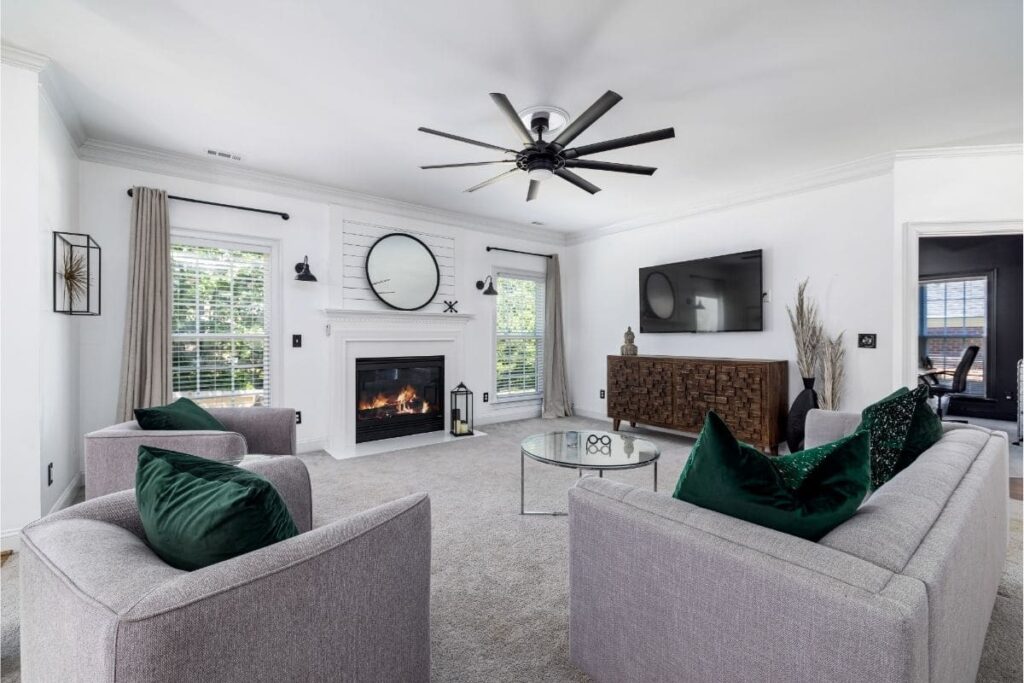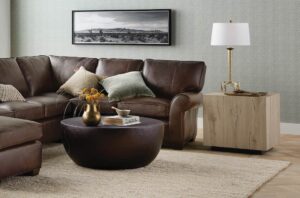Deciding between Klaussner vs Flexsteel furniture can be a dilemma for anyone seeking quality and durability in home furnishings.
These two brands are industry leaders, but with key differences that could significantly impact your purchasing decision. Therefore, we aim to offer an impartial comparison between Klaussner and Flexsteel, focusing on various essential criteria such as range, price, durability, and more.
By the end of this article, we intend to equip you with sufficient knowledge to make an informed choice tailored to your needs.
Quick Compare Klaussner vs Flexsteel
| Features/Attributes | Klaussner Home Furnishings | Flexsteel |
|---|---|---|
| Founded | 1963 as Stuart Furniture | 1893 as Rolph & Ball Furniture Company |
| Ownership Change | 1979 by Hans Klaussner | Acquired Flexsteel Spring Corporation in 1948 |
| Product Range | Extensive (sofas, beds, etc.) | Extensive (sofas, beds, etc.) |
| Price Range | Mid-range | Varies |
| Durability | Plywood, engineered wood | Known for craftsmanship and Blue Steel Spring |
| Warranty | Varies; lifetime on frames | Varies; lifetime limited on internal structures |
| Delivery | Quotes include boxing and crafting fees | Depends on retailer |
| Return Policy | 10-day notification period | Depends on retailer |
| Pros | Wide variety, customizable, sustainable practices | Over 75 years of expertise, known for durability |
| Cons | Contact dealers for best prices, shipment delays | Cannot buy directly, limited warranty |
Historical Background of Klaussner and Flexsteel
Understanding the history behind Klaussner or Flexsteel provides valuable context for comparing these two prominent furniture brands. Let us delve into their respective origins, growth trajectories, and pioneering technologies.
Initial Years of Klaussner as Stuart Furniture
Klaussner initially emerged as Stuart Furniture in 1963. Founded in Asheboro, North Carolina, the company primarily targeted the local market. Stuart Furniture focused on creating basic, yet functional, furniture items, and it gained modest success during its early years.
Hans Klaussner’s Impact on the Brand
The brand took a major turn when Hans Klaussner purchased it in 1979. The new ownership brought with it a vision for innovation and expansion. Under Hans Klaussner, the brand rapidly expanded its product range and reached new markets. Today, the company is known for offering a wide variety of furnishings that are both stylish and functional.
Note: Hans Klaussner is often credited with transforming the company from a small, local business to a nationally recognized brand.
The Foundation of Flexsteel in 1893
Moving onto Flexsteel, this brand was established much earlier, in 1893, originally known as the Rolph & Ball Furniture Company. Founded in Minneapolis, the company sought to create furniture pieces that would stand the test of time.
The Inclusion of Blue Steel Spring in Flexsteel Products
One significant milestone for Flexsteel came in 1927, when it patented its Blue Steel Spring technology. This innovation offered a substantial improvement in furniture durability and comfort. The Blue Steel Spring became a distinguishing feature for Flexsteel and remains a key component in its furniture even today.
| Key Historical Milestones | Klaussner | Flexsteel |
|---|---|---|
| Initial Years | 1963, as Stuart Furniture | 1893, as Rolph & Ball Furniture Co. |
| Pivotal Leadership Change | Hans Klaussner in 1979 | N/A |
| Significant Technological Advancement | N/A | Blue Steel Spring in 1927 |
We’ve walked through the crucial historical aspects of both brands, setting the stage for a more nuanced comparison in subsequent sections.
Manufacturing and Sustainability
Delving into the manufacturing processes and sustainability initiatives of Klaussner vs Flexsteel provides critical insight into their operational philosophies. These aspects often play a pivotal role in consumers’ decisions and offer another layer of comparison between the two brands.
Klaussner’s Local and Sustainable Manufacturing
Klaussner holds a significant presence in the U.S., notably in North Carolina, where it operates multiple manufacturing facilities. Sustainability is a focal point for the company, which incorporates eco-friendly practices, such as using recycled materials and employing energy-efficient technologies. This commitment reflects positively on the brand and aligns with growing consumer demand for environmentally responsible options.
Note: Klaussner’s emphasis on sustainability sets it apart in an industry often criticized for its environmental impact.
Percentage of Products Made in the USA for Klaussner
A significant proportion of Klaussner’s products are manufactured in the United States—approximately 85% by recent accounts. This contributes not only to local economies but also reduces the brand’s carbon footprint, as less transportation is required for domestically produced items.
Flexsteel’s Focus on Durability
Flexsteel places a high priority on durability in its manufacturing processes. From the patented Blue Steel Spring technology to the use of high-quality upholstery, the brand aims to produce long-lasting furniture. This focus on durability often leads to less frequent replacements and, consequently, less waste, indirectly contributing to sustainability.
Information on Flexsteel’s Manufacturing Locales
While Flexsteel operates internationally, it has manufacturing facilities located in several states within the U.S., such as Iowa and Mississippi. However, it’s worth noting that Flexsteel also sources some of its materials and products from overseas, making it a more global operation compared to Klaussner.
| Key Manufacturing Aspects | Klaussner | Flexsteel |
|---|---|---|
| Domestic Manufacturing Percentage | Approx. 85% | Varies |
| Focus | Sustainability | Durability |
| Notable Technologies | Eco-friendly practices | Blue Steel Spring |
This section has elucidated the manufacturing and sustainability practices of Klaussner and Flexsteel, shedding light on what each brand prioritizes in its operations.
Product Range and Customization
A vital aspect to consider while comparing Klaussner and Flexsteel is the diversity of their product offerings and the degree of customization they provide. Knowing what each brand specializes in and what customization options are available can significantly inform purchasing decisions.
Overview of Furniture Types Offered by Klaussner
Klaussner is recognized for its extensive selection of furniture, ranging from sofas and armchairs to bedroom sets and home accents. The brand has been able to carve a niche for itself in the home furniture sector by offering a wide variety of styles, from traditional to transitional.
Note: If you’re looking for a broad range of options, Klaussner may fit the bill.
Flexsteel’s Wide Array of Furnishings
Flexsteel also offers an impressive array of products. Their portfolio extends beyond living room furniture to include dining sets, office furniture, and even specialized furniture for RVs and boats. This variety demonstrates the brand’s versatility and ability to meet diverse consumer needs.
Customization Options Available in Klaussner Products
One area where Klaussner shines is customization. Many of their products can be tailored to specific preferences, from fabric types to design features. This level of personalization offers consumers the chance to be more involved in the design process, ensuring that the final product aligns closely with their needs and tastes.
Availability of Flexsteel Products Through Retailers
Flexsteel products are widely available through numerous retailers both online and offline. This wide distribution network makes it convenient for customers to experience the brand firsthand, although the customization options might not be as extensive as those offered by Klaussner.
| Parameters | Klaussner | Flexsteel |
|---|---|---|
| Types of Furniture | Broad range | Broad range |
| Customization Options | Extensive | Limited |
| Distribution | Direct & Retailers | Mostly through Retailers |
In essence, both Klaussner and Flexsteel offer a wide range of furniture options. However, Klaussner takes the lead in customization, while Flexsteel’s products are more readily accessible through a vast network of retailers.
Price Points and Affordability
The financial aspect of any purchasing decision cannot be ignored. Both Klaussner vs Flexsteel offer a variety of furniture at different price points. This section aims to elucidate the cost implications of choosing one brand over the other, touching upon the price ranges for different types of furniture and the target markets each brand seeks to serve.
Price Range for Klaussner’s Bedroom and Living Room Furniture
Klaussner offers a wide price range for its furniture, particularly in the bedroom and living room categories. Consumers can expect to find sofas starting at around $600 and extending up to $2,000 or more for premium designs. Bedroom sets are similarly priced, beginning at approximately $1,000.
Note: Klaussner offers a fairly broad price range, accommodating both budget-conscious and luxury-focused buyers.
Flexsteel’s Pricing for Comparable Items
Flexsteel’s pricing is generally on the higher end compared to Klaussner. Sofas, for example, might start at $1,000 and can go up to $3,000 or more for high-end models. Bedroom furniture is also on the expensive side, with sets often starting at $1,500.
Insight into Occasional and Reclining Furniture for Both Brands
For specialized furniture like occasional or reclining pieces, both brands offer competitive pricing. Klaussner’s occasional chairs can start at $250, whereas Flexsteel’s begin at $300. Recliners from both brands can range from $500 to $1,500, depending on the features.
Affordability and Target Markets for Both Brands
Klaussner aims to cater to a broad audience, offering furniture that is both affordable and mid-range. Flexsteel, on the other hand, targets a more upscale market, reflected in its higher pricing strategy.
| Factors | Klaussner | Flexsteel |
|---|---|---|
| Starting Price for Sofas | $600 | $1,000 |
| Bedroom Sets | From $1,000 | From $1,500 |
| Occasional Chairs | From $250 | From $300 |
By examining these factors, consumers can more effectively decide which brand aligns with their financial capabilities and home furnishing goals.
Material and Durability
The quality of material used and durability are pivotal factors that influence consumers’ furniture purchasing decisions. This section sheds light on the material composition and durability of products offered by Klaussner vs Flexsteel, and how these components contribute to the overall longevity of the items.
Klaussner’s Use of Plywood and Engineered Wood
Klaussner commonly employs plywood and engineered wood in their furniture, specifically for frames and shelving. These materials, while cost-effective, offer a reasonable level of durability and strength. However, they may not be as resilient as solid wood when it comes to wear and tear.
Note: Plywood and engineered wood are generally adequate for most home uses but may not be suitable for heavy-duty applications.
Special Collections from Klaussner Using Hardwood
For consumers seeking more robust options, Klaussner offers special collections that make use of hardwoods such as oak and mahogany. These hardwoods offer enhanced durability and a more refined aesthetic, albeit at a higher price point.
Flexsteel’s Blue Steel Spring and Its Longevity
Flexsteel sets itself apart through its patented Blue Steel Spring technology. This spring system, integrated into the furniture, is reputed for its exceptional durability, even outlasting the foam and upholstery. It’s one of the key reasons behind the long lifespan of Flexsteel’s products.
Customer Reports on Flexsteel Product Lifespan
Consumer reports suggest that Flexsteel products, owing to their quality materials and Blue Steel Spring technology, exhibit impressive longevity. Many customers report using their Flexsteel furniture for over a decade without experiencing significant wear or loss of comfort.
| Key Material | Klaussner | Flexsteel |
|---|---|---|
| Common Material for Frames | Plywood | Solid Wood |
| High-End Material Options | Hardwoods (oak, mahogany) | N/A |
| Notable Technology | N/A | Blue Steel Spring |
By evaluating these factors, one gains a clearer understanding of what each brand brings to the table regarding material quality and product durability.
Warranty and Customer Service
Warranties and customer service protocols are often decisive factors when choosing between furniture brands. This section elaborates on the warranties offered by Klaussner and Flexsteel and also highlights how warranty claims are processed by each company.
Warranty Details for Klaussner Frames, Springs, and Cushions
Klaussner offers limited warranties on its frames, springs, and cushions. Typically, frames come with a lifetime limited warranty, whereas springs and cushions often have varying warranty periods, usually ranging from 1 to 5 years.
Note: Always check the specific warranty details provided for each Klaussner product as they can differ.
Flexsteel’s Lifetime Limited Warranty
Flexsteel stands out for offering a lifetime limited warranty on the frame and their unique Blue Steel Spring technology. This warranty adds a layer of security for customers, making it a compelling feature of the brand.
Buyer Responsibilities for Returns for Both Brands
For both Klaussner vs Flexsteel, buyers are generally responsible for return shipping charges if they wish to make a warranty claim. Additionally, they must provide proof of purchase and may need to furnish photographs documenting the issue at hand.
How Warranty Claims are Processed for Each Brand
Klaussner typically requires the customer to reach out to the retailer from which the product was purchased for warranty claims. Flexsteel, on the other hand, provides a dedicated customer service portal where warranty claims can be directly processed.
| Criteria | Klaussner | Flexsteel |
|---|---|---|
| Frame Warranty | Lifetime Limited | Lifetime Limited |
| Spring Warranty | 1 to 5 years | Lifetime Limited |
| Cushion Warranty | 1 to 5 years | Variable |
| Return Shipping Charges | Buyer Responsibility | Buyer Responsibility |
By considering the warranties and customer service protocols of each brand, customers can make a more informed decision about their furniture purchase.
Conclusion
We’ve scrutinized various aspects of Klaussner vs Flexsteel, ranging from product range to customer service. The aim has been to provide a comprehensive understanding that enables potential buyers to make an educated decision.
Our analysis has spanned material quality, pricing, warranty options, and more. Both brands have their unique strengths and limitations.
Klaussner excels in local and sustainable manufacturing, while Flexsteel garners attention for its lifetime limited warranty on frames and springs.
Each brand offers distinct advantages, and the final choice may rest on individual preferences and requirements.
Armed with this information, prospective buyers can now proceed to review specific products from both brands to find the optimal fit for their needs.





